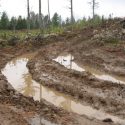Poll shows Wisconsin residents support wetlands protection
Wisconsin residents are concerned about the destruction of the state’s remaining wetlands but don’t know much about the wetland types that are most threatened, according to a recent statewide poll.
The Oct. 21-28 Badger Poll found that 84 percent of residents were concerned about the destruction of Wisconsin’s remaining wetlands, with more than half reporting they were “quite” or “extremely” concerned.
“Most people correctly identified only the most obvious kinds of wetland features,” says Bret Shaw, an assistant professor in the Department of Life Sciences Communication at the University of Wisconsin–Madison. “And that’s a concern in a state that has lost 47 percent of its original wetlands.
“Many view the presence of ducks, cattails and open water as defining features of wetlands when, in fact, they’re not,” Shaw adds. “The poll’s results suggest that people are much less familiar with the drier, less obvious wetlands. That’s a problem because these are the wetlands that face the most threats from development and from the rush to grow commodity crops.”
The state’s definition of wetlands identifies water-loving plants, wet soils and hydrology — or soils saturated with water — as the three defining characteristics.
Three-quarters of respondents said that cattails were required for wetlands, and more than 50 percent said that each ducks and open water were required for a wetland.
On the positive side, Shaw said, the overwhelming majority correctly identified the range of benefits that wetlands provide. Ninety-nine percent recognized wetlands as providing wildlife habitat, and at least 80 percent recognized other benefits of wetlands including filtering stormwater runoff, storing floodwaters, offering recreational opportunities and providing habitat for young fish.
“These results reaffirm the 180-degree shift we’ve seen over the last 50 years in public attitudes toward wetlands and their benefits,” Shaw says.
Throughout much of the state and nation’s history, wetlands were viewed as wastelands and obstacles to development, and federal laws provided incentives for draining wetlands and converting them to other uses. In Wisconsin, for instance, 4.7 million of the estimated 10 million acres of wetlands left by glaciers and other processes were drained and filled between the 1800s and 1970s.
The Badger Poll results indicate that Wisconsin residents support government offering incentives to protect and restore wetlands.
More than 86 percent supported giving private citizens a tax break if they protect or restore wetlands on their property, with more than 50 percent saying they were “quite supportive” or “extremely supportive” of such incentives.
Current tax law penalizes many property owners who want to restore wetlands on property now classified as agricultural land. Lands restored under certain government programs, such as the United States Department of Agriculture’s Wetlands Reserve Program, or without government assistance lose eligibility for agricultural classification for tax assessment purposes. The land is reclassified to “undeveloped land” which tends to be assessed at much higher values than agricultural lands.
The Badger Poll surveyed 538 people randomly chosen within households with working land lines and was weighted to correct for those with only cell phones. Results from this survey have a margin of error of a little over plus or minus 4 percent. The survey was commissioned by the Wisconsin Department of Natural Resources in partnership with Shaw to fulfill grant requirements for evaluating DNR outreach materials about the state’s drier wetlands.


